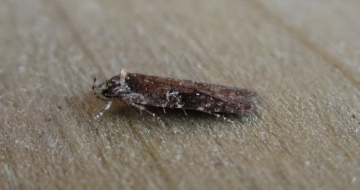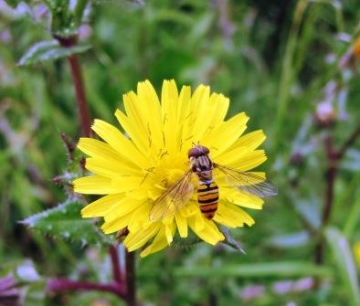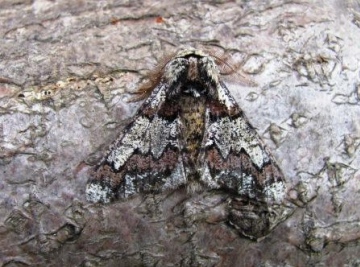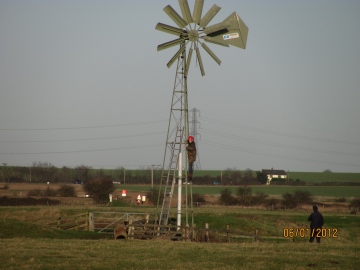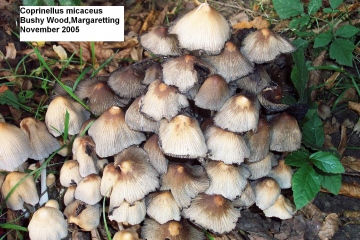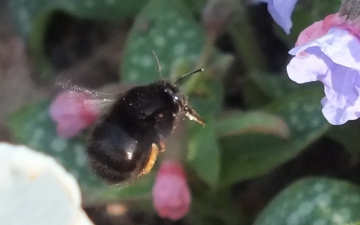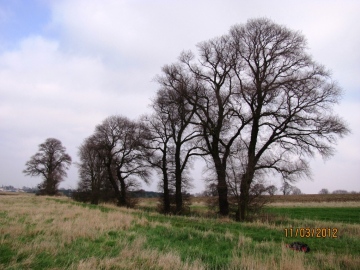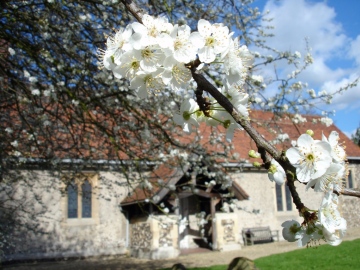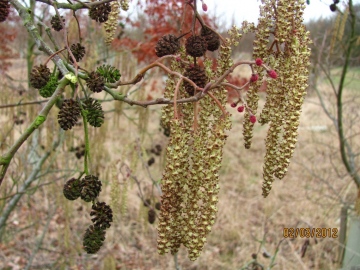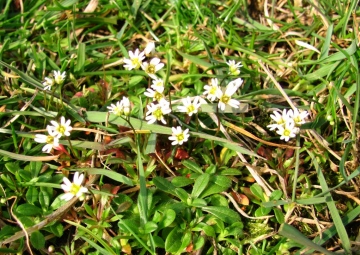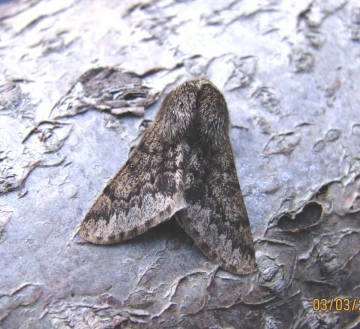Your Forum
The weblog below is for naturalists to use to report interesting sightings, ask questions, report on field meetings and generally post pictures and any information or questions generally relevant in some way to the wildlife and geology of Essex. You will need to register and be logged-on to post to the forum, and you need to upload pictures first, for use in posts. Find out more
|
Sat 31st March 2012 20:35 by Stephen Rolls Spring Moths.
The warm weather has helped us Moth trappers record large numbers of Spring Species, Orthosia species seem to have done very well this year with large numbers visiting my Braintree trap, 8 March trapping evenings produced 704 Small Quakers, 66 Hebrew Characters, 116 Common Quakers, 39 Clouded Drab and 14 Twin-spotted Quaker.
A knot Grass was found in a Polytunnel at work which is a very early record for this species which is usually recorded in May through to July.
Micro Moths have started to emerge from over-wintering with both Agonopterix and Acleris species being found in my polytunnels along with Stigmella and Elachista sp, a Leek Moth was also found today, my best find of Spring has been an Agonopterix purpurea [pictured] that was found during last week in a polytunnel, this quite a rare Moth in Essex.
I took an afternoon walk around Layer Wood in Tiptree with the hope of finding Orange underwing Moths flying around the Birch trees, they were easy to find with around 10 seen.
Sat 31st March 2012 15:50 by Graham Smith March 18th-24th 2012
Ah, the sounds of the mowers' mowers mowing on a Sunday afternoon when you are trying to enjoy a bit of peace and quiet in the garden. All those potential mini-meadows being scythed to billiard table smoothness. As Michael says, truly one of the sounds of spring. I even cut my own occasionally - kind of. One doesn't like to upset the neighbours and there is nothing like an unruly lawn for upsetting the sensibilities of many a gardener. But I cut mine midweek, when most people are at work and will not be disturbed. That's one of the joys of retirement. There is always a Plan B. Like when the train is cancelled (cable thieves again!). I simply wait for the next one, a smug smile hidden from view as I observe the agitated commuters all around me! My lawn cutting is a tortuous business as I weave the flymo between the patches of Lady's Smock and Field Wood Rush in the early spring, followed later by Germander Speedwell and Bulbous Buttercup, then Self Heal and Bird's-foot Trefoil, while in late summer I abandon it to swathes of Cat's Ear and Autumn Hawkbit. But the bits in between do get cut; that's my concession to respectability. When I was on my post-round and people commented that their lawns were in a terrible state and needed cutting I sometimes gave them a guided tour of the said plot, pointing out all the wild flowers growing in the grass. I think they were impressed, even if they figured I was up there with the fairies, but both they and I knew that such an argument was unlikely to wash with the neighbours. Buttercups and daisies all got the chop along with the likes of Lady's Bedstraw, Wild Carrot, Dog Daisy, Hardhead, Grey and Prickly Sedges. Even a couple of Green-winged Orchids on one lawn went the way of all weeds! A shame really, as having lost 98% of our wild flower meadows what is there left apart from churchyards and garden lawns?
As for finding the time to pen pieces like the above, Mary; most of the work I have to do on a computer is repetitive drudgery and it's a relief to spend an hour or so doing something a little bit creative. As for anyone reading it..........as I've mentioned before, this website has required a phenomenal effort to set up by Peter and it's a pity more people, members and non-members alike, don't use this part of it more to share their sightings. As for this particular week, a huge high pressure system settled across the country, deflecting the jet stream to the north, the result being seven days of glorious sunshine and exceptional temperatures, the latter approaching twice the national average (10-12`C at this time of year) on several days. It seemed almost unnatural, my mind getting way ahead of itself by seeking out Cuckoos and Nightingales long before they are due. I had to keep dragging it back to reality - a reality, however, that did include a small number of spring butterflies - Peacock, Brimstone, Small Tortiseshell and Comma among them. Rob Smith, the butterfly recorder tells me that there have been a few sightings of Red Admiral, Small and Green-veined White in the past week and even an exceptionally early sighting of a Holly Blue in Cambridgeshire. The garden has been full of Dark-edged Bee Flies (to give them their proper name) and there have also been a few Drone and Marmalade Flies (the latter pictured) and the long-tongued bee Anthophora plumipes, the ♂♂ of which are brown and the ♀♀ black. A fourth bumblebee species also turned up,Bombus pratorum, known as the Early Bumblebee, only this one was late! Finally, the cold, clear nights that followed the warm days seem to have held the moths in check, though, but I did catch a fine Oak Beauty. Elsewhere, 16- and 14-spot Ladybirds have been emerging from the rotting base of fence posts at Blue House, where they winter, often hundreds to a post, while Common Lizards were sunning themselves at Mill Green on 19th and a Grass Snake, still dopey from its winter sleep, at The Backwarden on 24th. Fri 30th March 2012 09:35 by Peter Harvey false widow
Certainly no spider would bite a human except as an involuntary reaction to perceived threat - they are basically only interested in prey, insects, other invertebrates etc, which they can feed on and would normally stay with their retreat and web. Certainly Steatoda nobilis and possibly Steatoda grossa shouldn't be handled with bare hands and there is a very slight possibility of the spider getting caught in clothing or footwear if it has been left lying around outdoors or in an outhouse. Fri 30th March 2012 09:13 by Lisa Thomson False widow
Thanks Peter, feel more reassured now. Someone said to me also (not sure if true) that it is only the females that bite and only if threatened. Fri 30th March 2012 07:18 by Peter Harvey False widow spider
There are a number of Steatoda species found in Britain, all so-called 'false widow' spiders. Three are possible in or near buildings, Steatoda bipunctata (very widespread and probably occurring in almost every house/outhouse/garden in the country), Steatoda grossa (widespread and sometimes very frequent in the southwest, but becomes much scarcer further north and east, but in the last few years seems to be increasing) and Steatoda nobilis, the one which gets the press for biting humans (originally confined to the south coast, now increasingly turning up elsewhere in southern England and found in 2006 in Barry, S. Wales). Steatoda nobilis has on occasions been responsible for bites, even though many of the cases publicised for this are almost certainly due to another cause, doctors commonly misdiagnose 'spider bites' and the media do not present an accurate or sensible story. Generally speaking people are vastly more likely to be stung by honey bees or social wasps, and spider bites are very rare. Steatoda spiders catch their prey using an untidy 'scaffold' web in corners, under window ledges etc and are generally unlikely to leave the webs to wander around, except when the males become adult and are looking for females. Fri 30th March 2012 06:53 by Lisa Thomson False widow spider
Yesterday I discovered what I believe to be false widow spiders on my decking, a couple of years ago a saw one in my shed but didn't think to much about it, however I have a seven year old and two younger grandsons who are always playing on or around the decking, should I be worried?.
I am pretty sure this is what they are as when I was younger I lived in Australia and these look just like the red back only with beige makings on there back rather than the red. Any help would be much appreciated. Wed 28th March 2012 01:14 by Michael Daniels Because Graham makes the effort
Sure Graham with his wide interesting in Natural History, he gets inspiration from what
he sees along with the effort he puts in to writing about his observations. Yes, he finds
the time, and many who also could likewise contribute to this forum. Mmmm, it means a
little more effort than just reading other's deliberations. At the last annual general meeting
there was a sizeable attendance. Say just a quarter of those at Balildon made the effort
to add their comments or simply reported what they have noticed in their garden, especially
now when we have some springlike weather; this would make my periodic visits to the web-
site mainly to read Graham, an added attraction.
Even here in Clacton, where the seasons usually start a bit late because of our closeness to coolling influence of the North Sea, there is much activity around this place. Our neighbour's elderly tortoise awoke from his winter slumbers and you can hear all the mowers going, thus varied signs of Spring on the way. So hope this note proves to have found some more good folk to give us a bit of feed back, or - idea - simply tell us of your garden bird's nesting activity.....it's time - it's April on Sunday! Michael in Holland-on-Sea Sat 24th March 2012 14:41 by Mary Smith First Peacock and Brimstone butterflies
In Lion Pit, near South Stifford and Chafford Hundred, yesterday, 23 March, I saw both of these butterflies. These are firsts for the season for me.
How does Graham Smith find the time to write all these interesting messages, at such length? Fri 23rd March 2012 17:19 by Graham Smith March 11th to 17th 2012
Blue House Farm EWT Reserve : Water levels on Round Marsh (otherwise known as The Flood) are finally approaching the optimum levels needed to attract breeding waders such as Lapwing, Redshank and Avocet. It has been a painfully long process as we have had yet another exceptionally dry winter. Under the licensing agreement with the Environment Agency the reserve is allowed to pump water on to Round Marsh whenever water levels reach a specified level in the main feeder ditches. In a normal year pumping operations usually begin in mid or late October but it was the first week of 2012 before they reached the critical level this winter and the wind pump could be turned on. You would think, in this day and age, that all you would have to do in order to start the pump would be to press a button but, no, the reserve warden, Nick Robson, or his assistant, Tim Lawrence, have to scale the structure using, firstly, a ladder, then a climbing harness. Once at the top all the working parts have to be lubricated, then a rope threaded through a ring on the end of a chain (see picture).
They then descend and half way down, when safely out of range of the revolving blades, pull on the rope - which is a bit like flushing the loo - and, hopefully, the pump creaks into action. Modern technology! It takes around 5-6 weeks for Round Marsh to flood to its fullest extent and as male Lapwings set up territory as early as late February it flooded only just in time this year. How long it remains flooded depends on what the weather has in store. This week there was little or no rain apart from the dribble from a half-hearted weather front that crossed the area on 17th. Apart from that there were two warm and sunny days, two that were cold and grey, and two were indifferent. A few Blackcaps have now returned from the Costa del Sol to join the earlier arriving Chiffchaffs on territory while a Firecrest was seen at Bradwell on 11th and Tim recorded the first Wheatear of the year at Blue House on 17th. The latter is one of the iconic spring migrants; no birdwatcher considers the spring to have truly arrived until he or she sees their first Wheatear, hopefully no later than mid-March. Believe me, after birdwatching for sixty-four years (I am told I started while in the pram) their arrival doesn't half cheer you up after a long winter! There was not much insect activity this week. Although there are plenty of bumblebees on the wing now I have still only seen the same three species that first appeared in late February. A few more flowers are appearing each week however - Creeping Corydalis and Hairy Wood Rush at Pheasanthouse Wood, Danbury and Field Pepperwort in my garden at Ingatestone being among them. The fungi season has also resumed; Martin Gregory fidning two Wood Blewits Lepista nuda on his lawn at Danbury while there was a fine cluster of Glistening Inkcap Coprinellus micaceus (so called because of the glistening crystals on the young cap) on the log where we gathered for lunch during a work party at Pheasanthouse on Saturday. I am cheating here, though, by including a photo from another location! Fri 23rd March 2012 17:12 by Peter Pearson Thu 22nd March 2012 15:27 by Mary Smith Bee-fly
I saw one yesterday in Aveley, and another today in my garden in Upminster. These are the first ones this year, as far as I have seen. Wed 14th March 2012 16:29 by Graham Smith March 4th to 10th 2012
Dengie Elms : This fine group of elms was photographed at Orplands Managed Retreat, Bradwell this week. Many trees such as these along the coastal fringe of the peninsular have survived the ravages of Dutch Elm Disease and sights like this are not uncommon there. They are the Small-leaved or East Anglian Elm Ulmus minor ssp. minor, a species that is thought to have been introduced into Britain from southern Europe during the Bronze Age. One theory for the resistance to disease of this species (compared with the English Elm Ulmus procera, mature trees of which have been all but wiped out) is that because they are outside their normal range and grow more slowly in our colder climate the spring-wood vessels in the twigs are smaller than usual and restrictive to the spread of the fungus that would kill them. It has also been mooted that the pendulous twigs on this species are unattractive to the beetle that spreads the fungus. Research has also indicated that the surviving trees may be hybrids and this too could be linked to their survival. During the past two decades over 2000 clones have been produced my micro propagation, in large part thanks to the efforts of an Essex nurseryman, Roy King, and these are now 12-15 years old and being sold for planting, for which information I am indebted to the Wikkipedia site! I hope the project succeeds as the cascades of bare twigs in winter and green foliage in summer are a wonderful spectacle.
On a gloomier note, I have now got my eye in for signs of Acute Oak Decline and am beginning to see it everywhere, Thrift Wood EWT Reserve, Bicnacre and Stoneymore Wood, Mill Green being two new sites found this week. It seems to attack relatively young oaks that are packed together in almost plantation like densities and have perhaps become stressed due to a water shortage during the recent dry years. Spring seems to have been on hold this week with three cold, damp days and little sign of the sun on the remainder, apart from Saturday, when the first Chiffchaff of my spring - having returned from his Spanish hols - was singing his approval of the Mill Green site where Rob Smith and myself have been working this winter. The lambs-tail catkins of Aspen are now in full flower and the first Blackthorn blooms appeared this week, so the amount of pollen and nectar available to insects is steadily increasing for when the sun returneth. Wed 14th March 2012 16:21 by Graham Smith The Night Shift
The two events you mention are kind of linked. I can still remember, as a kid, when an old boy (he was probably my age!) used to come along my street at dusk with a long pole and light the gas lamps, returning the next morning to snuff them out. The light they shed cast the village in a soft, almost Dickensian glow. Nowadays, of course, the electric street lights are much more powerful and what with neon signs, security lights and all the rest the place is lit up like the proverbial Christmas tree. Quite a number of birds - either fooled by or taking advantage of the bright lights, have taken to singing in the middle of the night, especially in early spring when their sap is rising! In the same way, the Peregrines that nest on tower blocks in London are often able to hunt through the night and the remains of nocturnal migrants such as Water Rail and Little Grebe have been found in their nests.
The same light pollution that has benefited them has also dimmed the stars but I too noticed the recent coming together of Jupiter and Venus (or at least had it pointed out to me) on 11th and was able to see the former's moons through the telescope I use for birdwatching. Sat 10th March 2012 09:19 by Michael Daniels The night shift
Is this unusual, Blackbird singing away at 1 am last night. Does he have a problem or has
his 'Blackberry' developed a fault? Expect someone will tell me.
Also for those who look across the landscape, but also up at the night sky; maybe of interest on the 15th to look westwards to view the conjuction between Jupiter and Venus. My astronomer cousin reminds me of this when these planets will be just 3.5 degree apart. Should be an interesting sight, given there is no cloud to obscure this minor spectacle, we'll be lucky! Fri 9th March 2012 20:52 by Peter Harvey
Dear Peter
Beetles are not mapped on the website, nor are other groups depending on what data is available in digitised format. This does not mean at all that the group does not have large numbers of records in the county - pine ladybird for example is widespread. The rare and scarce species were summarised by Peter Hammond in the Essex Naturalist 16 (1999) and 17 (2000) (these can be searched and read using the on-line archive Unlocking+the+Natural+History+Heritage+of+Essex), but of course there are many hundreds/thousands of other beetles recorded in the county. Thu 8th March 2012 20:34 by Peter Pearson Pine Ladybird (Exochomus quadripustulatus) 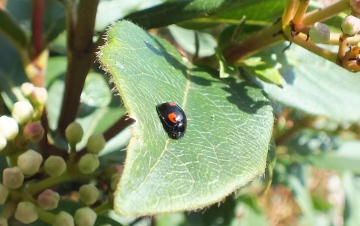 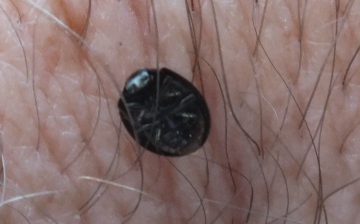 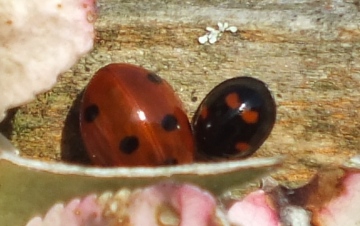
Over the years I have been submiiting records to the London and Essex Ladybird Survey. I was surprised to find that the Pine Ladybird (Exochomus quadripustulatus) does not appear on the species accounts and surveys and indeed I cannot find records of this insect on the site at all (maybe I am doing something wrong). The only reference I can find of the species in Essex, on the web is on the NBN Gateway maps where they are shown on the North Essex, Vice County Map in N.W.Essex. In recent years I have recorded an increasing number of Pine Ladybirds in the North Colchester and Mistley areas mainly on ornamental roadside trees. This increase seems to correspond to the enormous increase in scale insects in these areas. Is this a general trend in the county that is going unnoticed and unrecorded, and how best to record these and other species such as Kidney Spots encountered occasionally, but do not appear on species accounts. Mon 5th March 2012 12:30 by Graham Smith February 26th to March 3rd 2012
Spring progresses. Slowly. The 26th was a beautifully warm and sunny day and was spent doing conservation work at Mill Green with Rob Smith, the butterfly recorder. We raked at least three inches of topsoil off half the large area recently cleared of birches but left the other half untouched. It will be interesting to see whether there are any differences in the plants that colonize the two. In all probability all we've succeeded in doing is creating a seed bed for birch saplings but, more optimistically, the raked area may contain the seeds of a few of the rare and declining species found in the area, just waiting this chance to germinate. Certainly, when part of the area was last cleared around twenty years ago plants such as Pill, Oval and Yellow Sedges, and masses of Heath Bedstraw, were quick to respond, flourishing for a few years before the gorse and birch closed in again.
Cherry Plum (seen here in Margaretting Churchyard) and Sallow bushes are now coming into flower and providing a steadily increasing source of pollen and nectar for insects emerging from hibernation. On March 1st the temperature at Blue House Farm, North Fambridge reached 17'C and I spent my lunch break sitting in the sunshine next to the reserve's solitary sallow bush. During the half hour I was there the catkins were visited by single Peacock, Small Tortiseshell and Comma, masses of Honey Bees, two Buff-tailed Bumblebees and a Drone Fly, the last named the parent of the so-called Rat-tailed Maggot, a small white grub with a retractable breathing tube, which enables it to dwell in up to a foot of gunge in unsavoury places, such as the outflow from sewage pipes, while still managing to breath fresh air. It must surely need some! Other plants found in bloom this week have included the first Lesser Celandines, Alder (pictured here in the recently planted Bass Wood, Althorne) and Common Whitlow Grass (Blue House), the last named - despite its diminutive size - attracting a good number of Honey Bees and even the odd bumblebee. When the temperature soars to a giddy 17'C at this time of year you tend to get ahead of yourself, looking around for Wheatears and Swallows when they are still a few weeks away. The garden moth trap often helps to keep the spring momentum going, though. Such was the case this week as not only did it produce new moths for the year - Hebrew Character, Small Wainscot, Lead-coloured Drab (an attractive species believe it or not, despite the name) and Small Brindled Beauty (pictured) |
Archives: May 2020Aug 2019 Jan 2019 Sep 2018 Jul 2016 Oct 2015 Jul 2015 May 2015 Apr 2015 Mar 2015 Feb 2015 Jan 2015 Dec 2014 Oct 2014 Sep 2014 Aug 2014 Jul 2014 May 2014 Apr 2014 Mar 2014 Feb 2014 Jan 2014 Dec 2013 Nov 2013 Sep 2013 Aug 2013 Jul 2013 Jun 2013 May 2013 Apr 2013 Mar 2013 Feb 2013 Jan 2013 Dec 2012 Nov 2012 Oct 2012 Sep 2012 Aug 2012 Jul 2012 Jun 2012 May 2012 Apr 2012 Mar 2012 Feb 2012 Jan 2012 Dec 2011 Nov 2011 Oct 2011 Sep 2011 Aug 2011 Jul 2011 Jun 2011 May 2011 Apr 2011 Mar 2011 Feb 2011 Jan 2011 Dec 2010 Nov 2010 Oct 2010 Sep 2010 Aug 2010 Jul 2010 Jun 2010 May 2010 Apr 2010 Mar 2010 Feb 2010 Nov 2009 Oct 2009 Aug 2009 Jul 2009 Jun 2009 May 2009 Apr 2009 Mar 2009 Feb 2009 Jan 2009 Nov 2008 Oct 2008 Sep 2008 Aug 2008 Jul 2008 Jun 2008 May 2008 Apr 2008 Mar 2008 Feb 2008 Jan 2008 Dec 2007 Nov 2007 current posts |


















